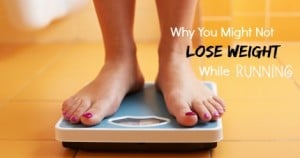Can you lose weight without sacrificing performance? The answer to this question of weight loss and performance comes with good and bad news. The good news: YES, you can lose weight without forfeiting your PR! The bad news: It is not an easy thing to accomplish. However, a runner who is willing to face distances like 13.1 miles, 26.2 miles, or beyond is not afraid to face challenges.
With that in mind, here are some guidelines to help you lose weight and keep working towards your PR.
First step, answer these weight loss and running performance questions
First, take an extremely honest evaluation of where your body is today and ask yourself the following questions.
- Am I currently at a healthy weight for my height and bone structure? (You can use this RunnersWorld BMI calculator for a good estimate)
- Is my ideal race weight/weight goal realistic? (dropping your BMI to less than 18.5 is detrimental to performance)
- Is my race weight/weight goal simply vanity weight? (Vanity weight is typically about 5-7 pounds that you desire to lose, but to be healthy and run well, it is not necessary to lose.)
- Do I have the time to invest in food preparation and planning?
- Am I emotionally ready to commit to the challenge?
Asking yourself these questions before you start your training and weight loss plan is extremely important. Often runners assume weighing less = faster, but this is not always true. Your body has a healthy weight range where it will perform at its maximum level. This healthy weight range for your body may or may not match what you believe should be your ideal race weight or the weight you would like to be for vanity’s sake.Your healthy weight range is typically your weight +/- 3 pounds when you are eating healthy, working out, and not focusing on your weight. For your body to gain or lose weight, you would have to experience some fairly significant diet and lifestyle changes.
Along with helping you establish realistic goals, these questions will also help you understand and embrace your race day results. When race day comes, you may experience a number of different results. The first and most ideal result is that you hit your weight goal, as well as your PR. Great. Your ideal weight was realistic for your body!
Nab Our FREE 4-part Weight Loss Email Course
You’ll learn the science behind losing weight and still running well so you can understand the “why” of weight loss for long-term success.
Lessons include why simply running more and eating less won’t help you lose weight, why your weight fluctuates each day, and the best way to distribute calories throughout your day. Plus more…
The second result you may experience is when you did everything right during your training and you ran your PR, but you didn’t lose weight. There is a good chance you are at a healthy weight and your ideal race weight was not realistic. Or finally, if you hit your weight goal, but didn’t run well due to fatigue, there is a good chance you dropped below your body’s ideal performance weight.
Your body and your race weight are extremely unique, and it may take a couple of races before you find the weight you race best at.
Invest time if you want to lose weight and still run well
Once you have established realistic goals, you need to be ready and willing to invest time into your food preparation and planning, just like you are willing to invest time into running the miles. We live in a society the moves a hundred miles an hour, so taking the time to prepare healthy, homemade meals will feel out of place and like a burden, but this could make or break your weight loss success.
Increasing your training miles and intensity, which is critical to running a PR, is almost guaranteed to increase your appetite. One extremely important key to losing weight while you are training is avoiding a scenario where you are starving without healthy food options available.
At the beginning of each week create a healthy meal plan and stick to it. Also, take time to plan pre- and post-run snacks and emergency snacks for those days you just can’t seem to fill the hole. Many runners don’t take the time to have healthy snacks and meals planned, so when the 3 o’clock snack attack comes around, they make poor snack choices.
I suggest being prepared with something that is healthy and filling, such as an apple with almond butter, instead of making a trip to the vending machine that you will regret later.
DON’T cut carbs too low
Carbohydrates are crucial for quality running, and cutting your consumption of carbohydrates too low will also cut your energy and performance.
To keep energy levels up but also lose weight, you need to replace about 1/3 to 1/2 of the traditional carbohydrates/grains you eat, like bagels and pasta, with healthier lower calorie options. Replacing 1/3 to 1/2 of the carbohydrates you eat is merely a general recommendation; be sure to listen to your body. If your energy levels seem low and runs haven’t been going well, add a few more traditional carbohydrates back into your diet. If your energy levels feel great, experiment with adding a few more vegetables to your daily routine where you would normally eat grains to help promote greater weight loss.
Vegetables are the perfect replacement for traditional carbohydrates because you still get carbohydrates and energy from them, but you also get more water and fiber, making them lower in calories and more filling. The beauty of vegetables is you can eat as many as you want. Here are a few examples where you can replace your traditional carbohydrates with vegetables.
Traditional breakfast: Eggs + Bagel w/jelly
- Try: Eggs + heaping plate of sauteed vegetables + piece of fruit
Traditional lunch: Turkey Sandwich + Potato Chips
- Try: Turkey Sandwich, loaded with lettuce, tomatoes, sprouts, avocado + huge salad
Traditional snack: Pretzels, Peanut butter + Banana
- Try: 1/2 the pretzels, carrot & celery sticks w/ peanut butter + banana
Traditional dinner: Spaghetti & Meatballs w/ dinner rolls (How many of us actually only eat one?)
- Try: 1/2 a serving of whole wheat spaghetti mixed with spaghetti squash + steamed vegetables and one dinner roll
Keep Your Focus!
Ultimately, from the start of your training schedule you need to know your main priority. If performance is your main priority, then let that be your focus and weight loss be secondary or vice versa. Often people lose sight of their main goal mid-training and emotionally get frustrated or stressed, which can affect both your running and your weight.
Losing weight and maintaining or increasing performance at the same time is a tricky balance, but it is possible with diligent planning. Use these guidelines during your next training schedule to increase your weight loss success and determine at what weight your body is strongest and performs best.





7 Responses
Are there any tips to finding your goal weight? For example, after losing a ton of weight, I find myself stuck around 175 for the past several months (I’m 5’11”).
My original goal was 165 but I’m not sure if that’s realistic or not. I definitely have visible fat I could lose and would love to get down to 165 but I seem to be stuck with the running. I might just have to lock down the diet again.
Great question Kyle!
Generally speaking,165 lbs on a 5’11” frame is a realistic and healthy goal, but at 175 lbs you are still at a healthy weight. One tip for finding your weight goal is determining your frame size/bone structure. A very simple gage for bone size you can do yourself is:
If your index finger and thumb can overlap around the smallest part of your wrist, you’re small boned.
If they can just touch, you’re medium boned.
If they don’t touch you’re large boned.
If you are large boned, even at 175 you are at a healthy weight. So that last 10 lbs you would like to lose is what I consider “vanity weight”. To get this weight off, you are really going to have to watch the diet again (real foods!!) and make sure you are faithful with your exercise. Also, if and when, you get down to 165 be sure to listen to you body and how you feel. If you seem to be more fatigued and tired at 165 lbs there is a good chance you are under your body’s preferred weight. Also, if you are doing everything in your power, aside from starving yourself, and you can’t seem to lose the last 10 pounds, then 175 may be where your body functions best!
I hope this helps! If you are serious about losing that last 10 lbs and would like some guidance, sign up for a consultation so we can look at your diet and body specifically!!
I use a formula I saw in Bicycling magazine. I am a muscular guy who weighs 157lbs~. According to BMI, I am overweight. However, when I drop down to 147~ I am fatigued and tired. I am currently training or Chocago Marathon. The formula is:
Step 1: Calculate current body fat mass. Body fat mass = current weight x current body fat percentage expressed in decimal form. In this example: 140 lbs x 0.22 = 30.8 lbs.
Step 2: Calculate current lean body mass. Lean body mass = current weight – fat mass. In this example: 140 lbs – 30.8 lbs = 109.2 lbs.
Step 3: Calculate goal weight. Goal weight = current lean body mass ÷ goal lean body mass percentage. (Note: goal lean body mass percentage is 1.0 – your goal body fat percentage expressed in decimal form.) In this example: 109.2 lbs ÷ 0.83 = 131.5 lbs. Ta-da!
Bill, I am glad you have figured your body out well enough to know that running at your “healthy” BMI is not the best for you. BMI is a good general number to help people find their healthiest body weight, but it is very general and does not apply to everyone!
Interestingly enough, BMI’s were actually created for insurance companies to rank people as healthy or overweight. This is why they are not more exact.
Thanks for the article Abby. Over the past year I went from running 3:21 in New York at 175 lbs. to running California International Marathon in 3:01 at 155 lbs. Adding weight loss to the great training Jeff has put me thru I was able to get my times down while turning 54 last month. I figured I can’t stop getting older but I can do something about my weight. In the heart of marathon training it was real tough making sure I was fueling my workouts while trimming fat. At 6′ tall I’m pretty sure I have a little more weight to lose while training for Chicago this fall. I agree with what you said about having the time and committment for meal planning is just as important as time for training. As I’ve committed to breaking 3 hours, I’ve fine tuned every aspect of performance to get the most out of myself. I’ve set a goal of being 145 lbs and breaking 3 hours in Chicago so I’ll be paying close attention to all your nutrition tips. Thanks so much
Dannis!
Wow, what a great story! Shaving 20 minutes off your time is incredible! I am so glad you recognized how important nutrition was in conjunction with your training! Good luck with your training & trimming this summer! Be sure to pay close attention to what your body is saying as you head towards that 145 goal. You want to make sure you have the energy to train hard! Best of luck!
Thanks for this post. I run mostly half marathons but am gearing up for marathon number 3. I was a fat kid and lost 30 pounds 12 years ago at age 21 and have kept it off, two babies later, and I am sure a lot of it has to do with the 40ish miles a week I run. I really want to lose about 3-5 more pounds, and was briefly there for about a month before my fall marathon, but only maintained it for about a month, so I am starting to think that my body just doesn’t want to go there. Formerly fat kids have their own very strange relationship with weight loss, scales, but days where I way too much just ruin my mood and I find myself eating depending on weight…which doesn’t seem to help….but of course am terrified if I ever let up I will get all chunky again….another symptom of formerly fat kid syndrome!!! Thanks again for the very affirming, helpful article.